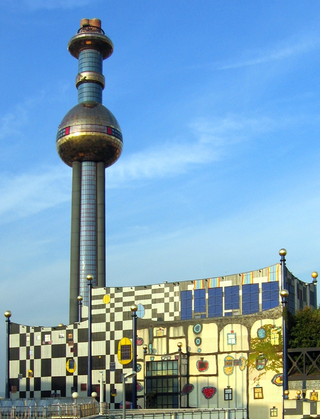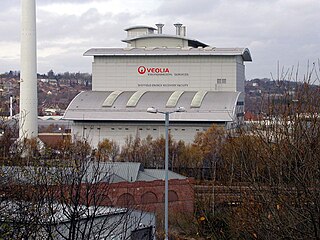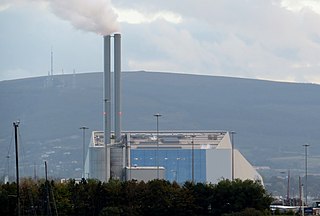
Incineration is a waste treatment process that involves the combustion of substances contained in waste materials. Industrial plants for waste incineration are commonly referred to as waste-to-energy facilities. Incineration and other high-temperature waste treatment systems are described as "thermal treatment". Incineration of waste materials converts the waste into ash, flue gas and heat. The ash is mostly formed by the inorganic constituents of the waste and may take the form of solid lumps or particulates carried by the flue gas. The flue gases must be cleaned of gaseous and particulate pollutants before they are dispersed into the atmosphere. In some cases, the heat that is generated by incineration can be used to generate electric power.

Stormbreaker is a 2006 action spy film directed by Geoffrey Sax. The screenplay by Anthony Horowitz is based on his 2000 novel Stormbreaker, the first novel in the Alex Rider series. The film stars Alex Pettyfer as Alex Rider, and also stars Mickey Rourke, Bill Nighy, Sophie Okonedo, Alicia Silverstone, Sarah Bolger, Stephen Fry and Ewan McGregor. Stormbreaker was an international co-production between companies and financiers from the United Kingdom, the United States, and Germany.

Waste-to-energy (WtE) or energy-from-waste (EfW) refers to a series of processes designed to convert waste materials into usable forms of energy, typically electricity or heat. As a form of energy recovery, WtE plays a crucial role in both waste management and sustainable energy production by reducing the volume of waste in landfills and providing an alternative energy source.

The Allington Quarry Waste Management Facility is an integrated waste management centre in Allington, Kent. It is the site of the Allington Energy from Waste (EfW) Incinerator. The incinerator is owned by FCC Environment as Kent Enviropower. The facility, which has involved an investment of over £150 Million, is able to process 500,000 tonnes per annum of waste and has the ability to produce 40MW of power. The facility takes non-hazardous waste from households and businesses in Kent and the surrounding area for recycling and energy recovery. Materials separated by householders are sorted and sent for recycling, with the remainder being used to generate electricity to power the facility and for the local supply network.

The Kirklees EfW is a major moving grate incineration plant in Huddersfield, Kirklees, England. The incinerator is owned and operated by Suez Recycling and Recovery UK who signed a 25-year contract with Kirklees Council in 1998 with an option to increase the time period to 2028. The plant is integral to the waste strategy and Unitary Development plan of Kirklees Council, treating 150,000 tonnes of locally generated municipal waste, which when incinerated, will produce enough electricity to power 15,000 homes. Only 136,000 tonnes of waste is actually incinerated, the other tonnages permitted are recovered materials such as metals and Incinerator bottom ash (IBA) and Fly ash.
The Bolton WtE is a waste power station constructed in 1971 in Bolton, and is a major landmark of its skyline. The incinerator burns up to 20 tonnes of household waste per hour or 85,000 t per year, and can generate up to 11 MW of electricity. The plant is operated by Suez Recycling and Recovery UK. The Bolton incinerator is the only household waste incinerator in Greater Manchester.

The Sheffield Energy Recovery Facility, also known as the Energy from Waste Plant, is a modern incinerator which treats Sheffield's household waste. It is notable as it not only provides electricity from the combustion of waste but also supplies heat to a local district heating scheme, making it one of the most advanced, energy efficient incineration plants in the UK. In 2004, the district heating network prevented 15,108 tonnes of CO2 from being released from buildings across the city, compared to energy derived from fossil fuels. The incinerator is a 'static asset' owned by Sheffield City Council and operated by Veolia Environmental Services under a 35 year integrated waste management contract (IWMC)/PFI contract.

South East London Combined Heat and Power, better known as SELCHP, is a major energy from waste incineration plant in Bermondsey, London. It was designed to generate both heat and electricity. The plant can generate up to 35 MegaWatts of power using a steam turbine in electricity only mode. It can incinerate up to 420,000 tonnes per year of municipal solid waste.

The Newhaven ERF is an incinerator, in the town of Newhaven in the English county of East Sussex, for the treatment of up to 210,000 tonnes per annum of the county's municipal solid waste. The facility, built by Veolia Environmental Services, was approved by planners at the Conservative-controlled East Sussex County Council.

The Newlincs EfW facility is an energy from waste facility which is located in Grimsby, North East Lincolnshire, England. The plant is operated by Cyclerval UK & TIRU Group under a PFI contract. The engineering of the facility is unusual as it consists of an oscillating kiln handling 56,000 tonnes of waste per year/7 tonnes per hour of waste. The facility is capable of generating 3.2 MW electricity.

Tyseley Energy Recovery Facility is a waste incineration plant in Birmingham, UK. It is run by Veolia for Birmingham City Council.

EcoPark is a waste-to-energy plant which burns waste from several London boroughs to provide electricity for the National Grid. It is located on the River Lee Navigation and bordered by the North Circular Road, in Edmonton in the London Borough of Enfield. It is also known as Edmonton EcoPark.
The Isle of Wight gasification facility is a municipal waste treatment plant in Newport, Isle of Wight. It entered the commissioning phase in autumn 2008, and was replaced by a moving grate incinerator in 2019.

Teesside Energy from Waste plant is a municipal waste incinerator and waste-to-energy power station, which provides 29.2 megawatts (MW) of electricity for the National Grid by burning 390,000 tonnes of household and commercial waste a year. It is located on the River Tees at Haverton Hill, east of Billingham in North East England. Developed and built by NEM, a subsidiary of Northumbrian Water, the initial plant replaced the Portrack Incinerator and opened in 1998. Subsequently, the facility became part of SITA, now Suez.

It is estimated that 290 million tonnes of waste was produced in the United Kingdom in 2008 but volumes are declining. In 2012 municipal solid waste generation was almost 30 million tonnes, according to Waste Atlas Platform.

Marchwood ERF is a waste incineration plant in Marchwood, near Southampton, England. It is situated beside the estuary of the River Test where it meets Southampton Water, opposite the Port of Southampton. It burns municipal waste and produces electricity for the National Grid.

The Dublin Waste-to-Energy Facility, also known as the Poolbeg Incinerator, is a waste-to-energy plant serving the Greater Dublin Area, located on the Poolbeg peninsula. The plant is capable of producing up to 60 megawatts of electricity, enough to power 80,000 homes, and provide district heating for up to 50,000 homes in the Dublin area. The facility will process up to 600,000 tonnes of waste per year. Poolbeg accepted its first delivery of waste on the 24th of April 2017.

Mjölnir and Stormbreaker, in the Marvel Cinematic Universe (MCU), are sentient enchanted weapons of choice used by Thor. Both are melee weapons and were created out of Uru metal forged with the heat of a dying star in the Dwarven kingdom of Nidavellir, with the assistance of the dwarf king and master weapon-maker Eitri. Mjolnir is a hammer, and was enchanted by Thor's father, Odin, so that only those the hammer deemed "worthy" are capable of wielding or even lifting it. Stormbreaker is an axe, and although it does not have such a worthiness enchantment, its power is such that a mere mortal attempting to wield it would be driven mad.

Gloucestershire Energy from Waste facility, also known as the Javelin Park Incinerator is an incinerator and energy-from-waste power station which produces 14.5MW of energy for the National Grid, by burning up to 190,000 tonnes of residual waste each year. The site is located adjacent to the M5 motorway, near junction 12 and to the south of Gloucester.

















